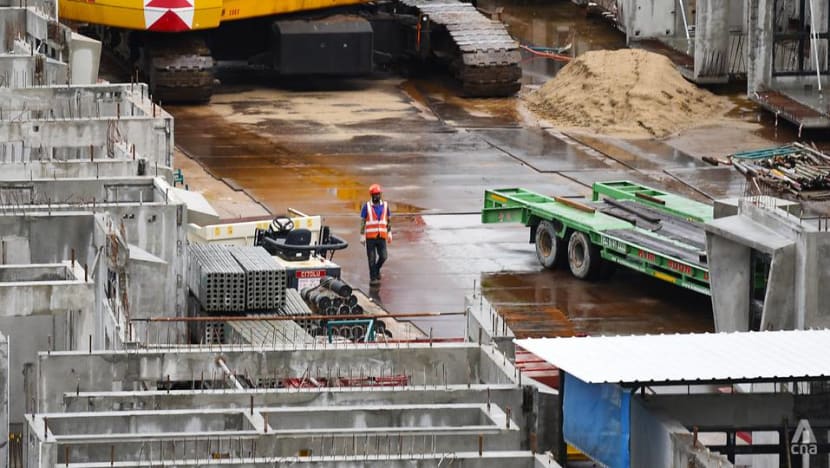Funding Asia's trillion-dollar infrastructure needs
Asia will need tens of trillions of dollars in infrastructure investments over the next decade. Money Mind looks at how the region’s bond markets can step up to the plate to help finance this.

A construction worker seen at a construction site in Singapore on May 18, 2020. (File photo: Calvin Oh)
SINGAPORE: Roads, water and sewage systems, ports, and railway lines. These are some big-ticket infrastructure items that all countries in Asia will need to invest in to maintain growth momentum, tackle poverty and respond to climate change.
According to the Asian Development Bank, Asia's infrastructure needs are expected to cost about US$26 trillion between 2016 and 2030. That works out to more than US$1.7 trillion per year.
The COVID-19 pandemic has inflated the bill further, with extra funds needed in sectors such as healthcare, sanitation and information technology infrastructure.
At the same time, government coffers are being depleted as they pour in money to help their pandemic-hit economies.
Given this double whammy and the scale of the numbers, it will be difficult to plug the gap through public sector funding alone, said industry watchers.
The money for infrastructure projects will thus have to come from the private sector.
Budget 2021: Government plans to issue new bonds to finance major, long-term infrastructure
The banks will not be the key source of financing though. Industry players said relying on banks for financing is not healthy practice, as seen during the Asian financial crisis of 1997.
“At that time, the bond markets across Asia were not as vibrant and much of the debt burden was held by a handful of banks. So when there was stress, this handful of banks couldn't hold it and the domino effect led to the Asian banking crisis," said Mr Clifford Lee, global head of fixed income at DBS.
"The healthier way is to introduce the debt financing needs into the debt capital markets for funding to be provided through many investors through the market itself, so that any volatility or credit stress in the future is cushioned and spread out,” he added.
This increases the need for the region’s capital markets to take on a bigger role in infrastructure financing.
Asian firms are already issuing bonds that are denominated in the G3 currencies - the US dollar, the euro and the Japanese yen. This market has more than doubled in valued since 2014. Experts said the continued growth is a sign of its potential.
Industry players said foreign investors will drive the next stage of growth in the Asian G3 bond markets.
“Over the past 10 years or so, many of these bonds have been taken up by Asian investors. The rest of the world has yet to participate in the Asian G3 bond markets in a bigger and more meaningful way," said Mr Lee.
"The reason for that is really a lack of supply. There is no lack of interest in participating in Asia’s economic growth via the bond market. The real shortcoming is that of supply, meaningful supply and steady constant supply,” he added.
There is also scope for the region’s capital markets to expand further to include bonds that are denominated in the local currency of each country.
“This local currency bond market is still developing. There are some benefits of local currency bond markets - for example, it helps to mitigate currency and maturity mismatch which actually caused the Asian financial crisis. More needs to be done in the local currency bond market though. For example, the liquidity has to be improved, investor base can be further broadened,” said Asian Development Bank economist Shu Tian.
Mr Alfonso Garcia Mora, vice president for Asia and the Pacific at International Finance Corp, added that liquidity is "critical".
“The one thing that is critical for capital markets development is to make sure that you have the liquidity that is needed for the investor to be able to sell the instrument in the market, whenever they think that it is their right to sell. If you don't have that capacity. It is very difficult for an investor to enter into a very long-term engagement.”
It will take time to build up liquidity in local currency bond markets.
Commentary: Funding Singapore’s major infrastructure projects a tricky business
To that end, Singapore expects to issue its first tranche of Singapore Government Securities or SGS (Infrastructure) bonds in the fourth quarter.
The bonds will be created under the Significant Infrastructure Government Loan Act or Singa.
The proceeds from Singa bonds will be used to fund major long-term infrastructure projects such as new rail lines and coastal protection projects.
ADB's Ms Tian said these bonds are an important milestone in the development of Singapore’s local currency bond market.
“The new Singa bonds will further spur the supply of infrastructure and green bonds in the market, which also add liquidity to the markets, and the issuance of new Singa bonds helps to boost investors’ awareness of this asset class. They will also boost the demand for infrastructure and green projects by providing long-term instruments to participate in these projects,” said Ms Tian.
Mr Mora added: “The objective here will be long-term finance for infrastructure. So it will deepen the capacity of the government to invest in specific problems.
"The capital markets in the world are going more and more in that direction. If you look at the spectrum of instruments in the market - green bonds, impact bonds, social bonds - there is a clear ask or request by investors to target the bonds that they buy to the final objective of that bond.”
Singa bonds are plain vanilla bonds backed by the Singapore government’s balance sheet. This is unlike traditional infrastructure project bonds, which are backed by infrastructure projects.
Further ahead, industry watchers said Singapore can issue such pure-play infrastructure project bonds.
“It's almost the next logical step that's worth exploring. But when you're going from somewhat shallower or bond markets with a shorter history, it does take time and it makes sense to do this in steps because it's also about ensuring the market doesn't have too much indigestion by issuing a whole lot of very long maturity bonds in one go," said Mr Manpreet Gill, head of fixed income, currencies and commodities strategy at Standard Chartered Private Bank.
"Directionally, it absolutely sounds quite interesting. It will also be important to test the investor appetite for this sort of more long-term, more structured issuance. But when you think about developing the Sing dollar bond market, these are the kind of steps and the direction the market has to go in.”












